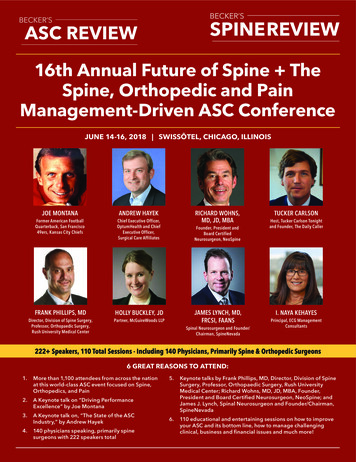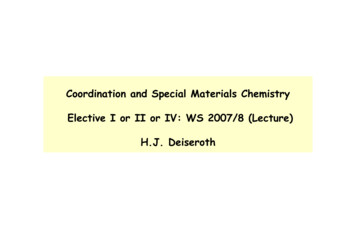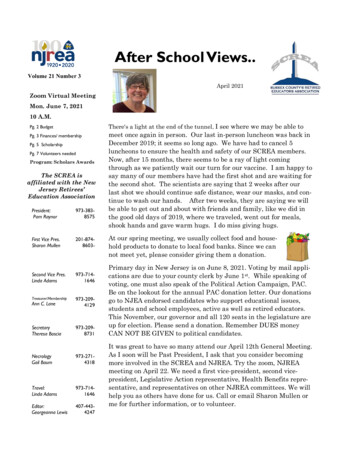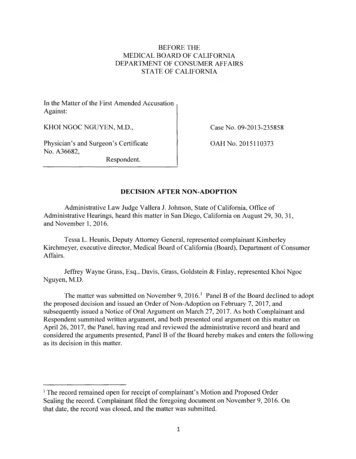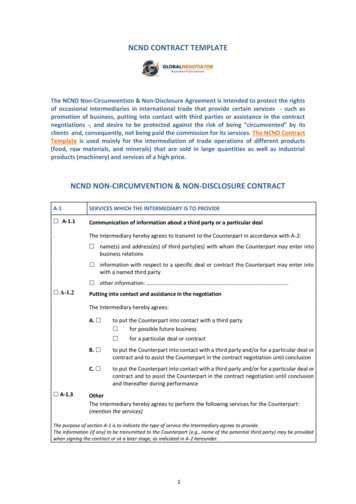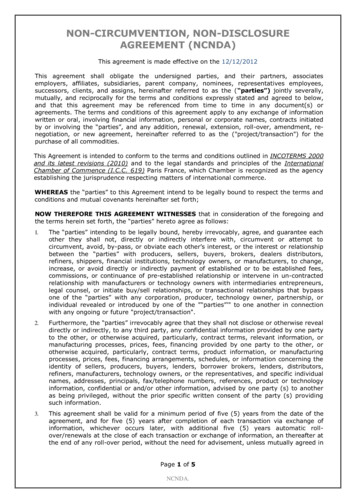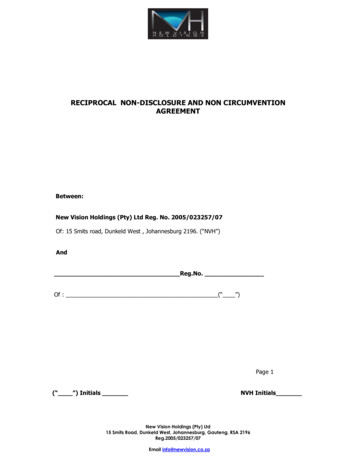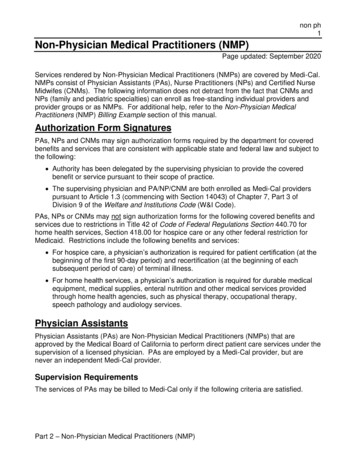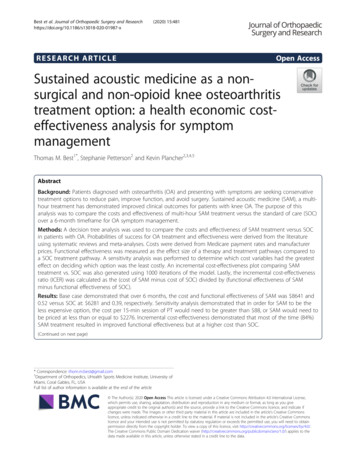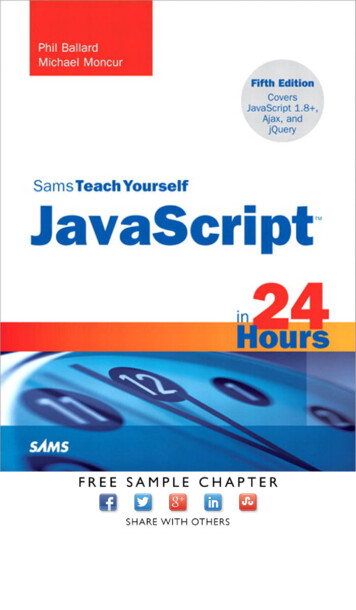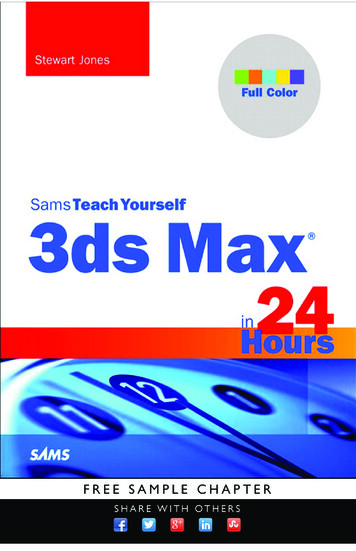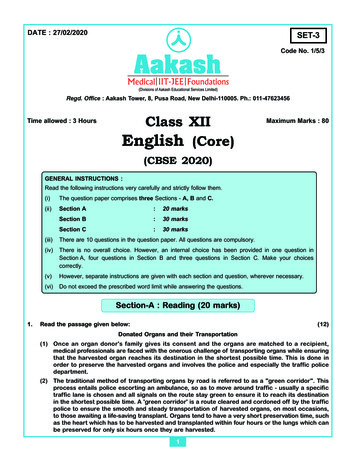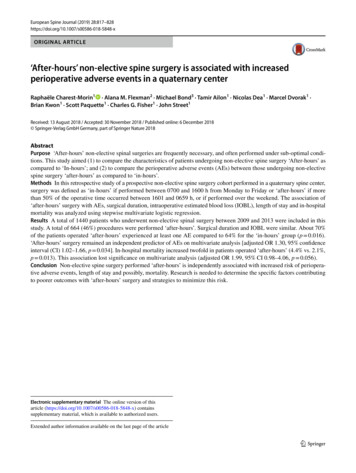
Transcription
European Spine Journal (2019) 8-xORIGINAL ARTICLE‘After‑hours’ non‑elective spine surgery is associated with increasedperioperative adverse events in a quaternary centerRaphaële Charest‑Morin1 · Alana M. Flexman2 · Michael Bond3 · Tamir Ailon1 · Nicolas Dea1 · Marcel Dvorak1 ·Brian Kwon1 · Scott Paquette1 · Charles G. Fisher1 · John Street1Received: 13 August 2018 / Accepted: 30 November 2018 / Published online: 6 December 2018 Springer-Verlag GmbH Germany, part of Springer Nature 2018AbstractPurpose ‘After-hours’ non-elective spinal surgeries are frequently necessary, and often performed under sub-optimal conditions. This study aimed (1) to compare the characteristics of patients undergoing non-elective spine surgery ‘After-hours’ ascompared to ‘In-hours’; and (2) to compare the perioperative adverse events (AEs) between those undergoing non-electivespine surgery ‘after-hours’ as compared to ‘in-hours’.Methods In this retrospective study of a prospective non-elective spine surgery cohort performed in a quaternary spine center,surgery was defined as ‘in-hours’ if performed between 0700 and 1600 h from Monday to Friday or ‘after-hours’ if morethan 50% of the operative time occurred between 1601 and 0659 h, or if performed over the weekend. The association of‘after-hours’ surgery with AEs, surgical duration, intraoperative estimated blood loss (IOBL), length of stay and in-hospitalmortality was analyzed using stepwise multivariate logistic regression.Results A total of 1440 patients who underwent non-elective spinal surgery between 2009 and 2013 were included in thisstudy. A total of 664 (46%) procedures were performed ‘after-hours’. Surgical duration and IOBL were similar. About 70%of the patients operated ‘after-hours’ experienced at least one AE compared to 64% for the ‘in-hours’ group (p 0.016).‘After-hours’ surgery remained an independent predictor of AEs on multivariate analysis [adjusted OR 1.30, 95% confidenceinterval (CI) 1.02–1.66, p 0.034]. In-hospital mortality increased twofold in patients operated ‘after-hours’ (4.4% vs. 2.1%,p 0.013). This association lost significance on multivariate analysis (adjusted OR 1.99, 95% CI 0.98–4.06, p 0.056).Conclusion Non-elective spine surgery performed ‘after-hours’ is independently associated with increased risk of perioperative adverse events, length of stay and possibly, mortality. Research is needed to determine the specific factors contributingto poorer outcomes with ‘after-hours’ surgery and strategies to minimize this risk.Electronic supplementary material The online version of thisarticle (https ://doi.org/10.1007/s0058 6-018-5848-x) containssupplementary material, which is available to authorized users.Extended author information available on the last page of the article13Vol.:(0123456789)
818European Spine Journal (2019) 28:817–828Graphical abstract These slides can be retrieved under Electronic Supplementary Material.A total of 1440 underwent non-elec ve spine surgery between January 2009 and December 2014.664 (46.1%) had surgery ‘a er-hours’776 (53.9%) had surgery ‘in-hours’Key points‘after-hours’, out of hours, adverse event, complication, in-hospital mortality,length of stay, surgical duration, intra-operative blood loss, spineAssocia on between ‘a er-hours’ surgery and peri-opera ve Adverse Events in nonelec ve spine surgery‘A er-Hours’Unadjusted ORAdjusted OR95% CIp1.301.301.02-1.6660.0341. After-hours’ non elective spinal surgeries are frequently necessary, and oftenperformed under sub-optimal conditions.Age- surgical complexity (SSII)- diagnosis- severity of the neurologic injury (ASIA) were also predictors of AEs in the finalmul variate model.2. The objectives were to compare non elective spine surgery performed ‘afterhours’ to those performed in regular operating hours with respect to operativetime, in-hospital mortality, length of stay, intraoperative and postoperative AEs.3. Definitions‘In-hours’: Surgery completed between 7h00 and 16h00‘After-hours’: Surgery where more than 50% of the operative time was between16h01 and 6h59, or if it was performed over the weekend.Charest-Morin R, Flexman AM, Bond M, Ailon T, Dea N, Dvorak MF, Kwon BK, Pasquette S,Fisher CG, Street JT (2018) ‘After-Hours’ Non-Elective Spine Surgery Is Associated WithIncreased Perioperative Adverse Events in a Quaternary Center. Eur Spine J;Take Home Messages‘After-Hours’Non Elective Spine Surgery:1. Was independently associated with increased risk of peri-operative adverse eventsand length of stay.A er-hoursIn-hourspOR me190 (SD 118)189 (SD 113)0.992EBL570 (SD 1101)536 (SD 667)0.5142. Showed a two-fold increase in-hospital mortality in patients operated ‘afterhours’. This association lost significance on multivariate analysis (p 0.056).Length of stay14 [IQR 21]13 [IQR 7]0.0143. Was not associated with surgical duration or intraoperative estimated blood loss.In-Hospital Mortality29 (4.4 %)16 (2.1%)0.013On mul variate analysis, ‘a er-hours’ was a predictor of length of stay but was not a predictor of in-hospital mortality.Charest-Morin R, Flexman AM, Bond M, Ailon T, Dea N, Dvorak MF, Kwon BK, Pasquette S,Fisher CG, Street JT (2018) ‘After-Hours’ Non-Elective Spine Surgery Is Associated WithIncreased Perioperative Adverse Events in a Quaternary Center. Eur Spine J;Charest-Morin R, Flexman AM, Bond M, Ailon T, Dea N, Dvorak MF, Kwon BK, Pasquette S,Fisher CG, Street JT (2018) ‘After-Hours’ Non-Elective Spine Surgery Is Associated WithIncreased Perioperative Adverse Events in a Quaternary Center. Eur Spine J;Keywords ‘After-hours’ · Out of hours · Adverse event · Complication · In-hospital mortality · Length of stay · Surgicalduration · Intraoperative blood loss · SpineIntroductionAccording to the Health Care Quality Initiative publishedby the Institute of Medicine, surgical complications arethe second most common cause of preventable mortalityand morbidity after medication-related complications [1].Surgical team fatigue, prolonged working hours and sleepdeprivation have been shown to impair surgical performanceand increase technical errors in the operating room [2]. Inaddition, in many centers, ‘after-hours’ surgery is oftenperformed with a perioperative team less familiar with thespecific surgical techniques. Procedures requiring complexspinal instrumentation may be hindered by a lack of specialized biomedical, radiographic and implant personnel duringthe ‘after-hours’ period.The association between adverse events and surgery performed ‘after-hours’ been reported in anesthesiology and anumber of surgical specialties including orthopedic surgery,general surgery, cardiac surgery [3–6]. Dedicated daytimeemergency orthopedic trauma rooms implemented to reduceafter-hours surgery have improved operating suite flow anddecreased complications [7, 8]. However, the relationshipbetween surgical time of day and postoperative outcomes hasbeen variable in different surgical populations, with otherstudies demonstrating no relationship [4, 9, 10].At our institution, ‘after-hours’ surgery is frequentlyrequired due to a combination of system and patient factors. When assessed prospectively, spine surgery is associated with a high rate of perioperative adverse events, andwe have previously reported an intraoperative and postoperative AE rate for spinal surgery of 10.5 and 73.5%,respectively [11]. However, the relationship between ‘afterhours’ spine surgery and perioperative AEs has never beenstudied. Given the vulnerability of the spine population and13given the complexity of these interventions from an surgical and anesthetic point of view, the relationship between‘after-hours’ surgery and perioperative AEs and mortalityis important information. The timing of spine surgery is apotentially modifiable system factor, with the potential toimprove patient outcomes. The objectives of this study wereto (1) compare the characteristics of patients undergoingnon-elective spine surgery ‘After-hours’ as compared to ‘Inhours’; and (2) to compare the perioperative AEs, surgicalduration, IOBL, length of stay (LOS) and in-hospital mortality between those undergoing non-elective spine surgery‘after-hours’ as compared to ‘in-hours’. We hypothesizedthat ‘after-hours’ performance of non-elective spine surgeryis associated with increased perioperative adverse events,surgical duration, IOBL, LOS and mortality compared tosimilar cases performed during regular working hours.MethodsWe performed this retrospective study of a prospectivecohort with ethics approval from our Institutional ResearchEthics Board (H14-03364) with a waiver for informedconsent.Patients and proceduresAll consecutive patients who underwent non-elective spinesurgery at our institution between January 1st, 2009, toDecember 31st, 2013, were included in the study. Ours isa Level 1 Trauma Center and quaternary academic teaching center in a major metropolitan center in Canada, witha catchment population of over 4 million people. Thesepatients came from the emergency room or were direct
European Spine Journal (2019) 28:817–828transfer from other peripheral hospitals. Cases were bookedby the attending surgeon on a priority basis. At our institution during the period of the study, cases were triaged basedon urgency, discussion with the surgeon(s) and time of booking by the in-charge anesthesiologist and nursing team, taking into consideration the urgency of the case as well asoperative room access. The date range chosen reflected aperiod of relatively consistent surgical scheduling practices.Seven fellowship-trained spine surgeons (three neurosurgeons and four orthopedic surgeons), fellows and residentsprovided surgical care. The attending spine surgeon andanesthesiologist were present at the operation. Between 1600and 0700 h the nursing, radiology and anesthesiology teamsare not specifically subspecialized.‘After‑hours’ versus ‘in‑hours’ classificationPatients were identified in two groups: the ‘in-hours’ groupdefined as surgery occurring between 0700 and 1600 h fromMonday to Friday and the ‘after-hours’ group defined assurgery where greater than 50% of the case was performedbetween 16h01 and 06h59 from Monday to Friday or whensurgery occurred at any time during the weekend (Saturday and Sunday). For example, a surgery starting at 14h00on a Monday and finishing at 20h00 would be classified inthe ‘after-hours’ group. This left 9 h in the ‘in-hours’ categery and 15 h in the ‘after-hours’ category. The definitionof ‘after-hours’ is somewhat arbitrary and reflect our institution’s practice. At our hospital, from Monday to Friday,07h00 until 16h00, spine surgery cases are performed withthe support of a neuro-anesthesiologist and dedicated nursing and support staff, who are trained in, and experiencedin spine surgery. Furthermore, implant/instrument industryrepresentative is usually on site. The percentage of timespent ‘after-hour’ was calculated by dividing the minutesspent ‘after-hours’ (between 16h01 and 6h59 from Mondayto Friday) by the total surgical duration.Predictor variablesBased on diagnosis, surgical cases were grouped as follows: Acute trauma an acute spinal fracture with or withoutspinal cord injury; Emergent oncology pathologic fracture, epidural cordcompression secondary to a neoplasm or acute neurologic deterioration of an intra-dural tumor; Infection acute postoperative surgical site infection orprimary spondylodiscitis/osteomyelitis/epidural abscess; Degenerative typically acute disk herniation with nerveroot deficit/cauda equina, rapidly progressive cervicalmyelopathy;819 Other e.g., baclofen pump malfunction, postoperativeepidural hematoma, active and symptomatic cerebrospinal fluid leak.Age, gender, American Spinal Injury Association (ASIA)Impairment Scale (AIS) grade, neurologic level and specificsregarding surgery (type of approach, level(s) decompressed,instrumented or fused, type of reconstruction, bone graft utilization, operation date, surgical duration) were collected ina prospective standardized fashion. Comorbidity data weregenerated retrospectively by review of the Electronic Medical Record. The surgical complexity was calculated usingthe Spine Surgical Invasiveness Index system (SSII). Alldata elements for the SSII were prospectively collected in acomprehensive ‘operative details’ database [12]. The SSIIis an instrument that accounts for the number of vertebrallevels decompressed, fused and instrumented, as well as thesurgical approach. The score ranges from 0 to 48 points,with a higher score indicating greater surgical invasiveness.Outcome measuresOur primary outcome was any adverse event (AE). Allpostoperative outcome data were recorded prospectivelyusing the Spine Adverse Event Severity system, version 2[SAVES V2]. This validated and reliable tool has been usedat our institution since 2008 (‘Appendix 1’ section) [13].Length of hospital stay, in-hospital mortality, surgery startand end time and estimated blood loss were also collectedprospectively.Statistical analysesData were described using mean [standard deviation (SD)],median [interquartile range (IQR)] or percentage, as appropriate. We first compared the characteristics of patients whounderwent ‘after-hours’ surgery with ‘in-hours’ surgery,using a Chi-squared test, independent t-test or analysis ofvariance as appropriate.We examined the relationship between ‘after-hours’surgery and our primary outcome of any adverse event. Toanalyze the relationship between ‘after-hours’ surgery andadverse outcomes, we first compared the patient and procedural characteristics of the populations with and without anadverse event using a Chi-squared test, independent t-test oranalysis of variance, as appropriate. Unadjusted odds ratioswere generated using logistic regression. We used a stepwisemultivariate logistic regression model with backward elimination (with a significance level of p 0.05 for inclusion inthe model), with the variable ‘after-hours’ was forced intothe model. Model performance was determined using assessments of discrimination (c-statistic) and calibration (Hosmer–Lemeshow goodness-of-fit test). When designing this13
820study, it was anticipated that long surgeries (with potentiallymore AEs) would extend into the ‘after-hours’ period and beincluded in the ‘after-hours’ group. To further explore andvalidate the relationship between surgical timing and ourprimary composite outcomes, we performed a secondaryanalysis using the ‘percentage of time spent after-hours’,instead of the dichotomous variable ‘after-hours’ using asimilar logistic regression model.Other secondary analyses included examining the relationship between ‘after-hours’ surgery with hospital lengthof stay, and in-hospital mortality. These relationships wereanalyzed using Poisson regression, and logistic regressionfor mortality and length of stay, respectively. Finally, wecompared intraoperative blood loss between the ‘in-hours’and ‘after-hours’ groups using a Wilcoxon sign rank test. Alldata analysis was performed using SAS Version 9.4 (SASInstitute, Cary, North Carolina) and STATA 12.1 (StataCorp,Texas, USA). All tests were two-tailed and a p value 0.05was considered statistically significant.Although we did not perform a formal sample size calculation, we used a prior study from our institution to estimatethat the date range chosen would yield a sufficient samplesize of approximately 2000 non-elective spine surgerypatients with an 87% rate of adverse event [11].ResultsStudy populationA total of 1440 patients underwent non-elective spine surgery and were included in the final analysis. The study population characteristics are summarized in Table 1. A total of772 (53.8%) procedures were performed during ‘In hours’and 664 (46.1%) procedures were performed ‘after-hours.’Of these, 344 (52%), 180 (27%) and 140 (21%) occurredduring weekday evenings or nights, weekend days and weekend evenings or nights, respectively. About 48% of the totaloperative time occurred in the ‘After-hours’ period. Of thosegrouped as ‘after-hours’, 96% of the operative time occurredin the after-hours periods. Conversely, only 7% of the operative time in the ‘in-hours’ group occurred in the after-hoursperiod.Comparison between ‘after‑hours’ and ‘in‑hours’patient populationThe group of patients who underwent ‘after-hours’ surgerywas more likely to be younger, smokers, have concurrentpolytrauma or malignancy, and have AIS A and B severitiesof neurologic impairment. SSII, male sex and other comorbidities were similar between the groups. In our multivariate13European Spine Journal (2019) 28:817–828Table 1 Study population characteristics, stratified by ‘After-hours’and ‘In-hours’ surgical timing‘After-hours’ group ‘In-hours’ groups p valueAge (mean SD)49 (19)Male (%)443 (67)Current smoker120 (18)(%)ComorbidityCardiac110 (17)Pulmonary65 (10)Concurrent pol130 (20)ytraumaMalignancy79 (12)Diabetes74 (11)Hematologic13 (2)diseaseImmunosuppres35 (5)sionNeurologic53 (8)diseasePolysubstance18 (3)abuseAnkylosing spon- 40 (6)dylitisPrevious cord3 (0)injuryDiagnosis categoryTrauma355 (53)Oncology65 (10)Infection54 (8)Degenerative183 (28)Others7 (1)Surgical locationCervical236 (35)Thoracic231 (35)Lumbosacral184 (28)Combined*13 (2)ASIA impairment scaleASIA A and B138 (21)(%)Unknown (%)88 (13)SSII (mean SD)8.6 (7)104 (16)Anteriorapproach tocervical spine(%)53 (18)487 (63)99 (13)0.00040.1170.004130 (17)75 (10)92 (12)0.3550.345 0.001119 (15)80 (10)21 (3)0.0670.3530.10350 (6)0.28763 (8)0.26818 (2)0.63540 (5)0.3047 (1)0.305322 (41)104 (13)77 (10)263 (34)10 (1)268 (34)294 (38)189 (24)25 (3)84 (11)126 (16)8.3 (7)98 (13)0.00020.1651 0.0010.41830.098*Combined refers to the treatment of 2 locations (example: a c5–T1fusion and a T6–T10 fusion during the same surgical setting)logistic regression below, we controlled for these baselinedifferences.
European Spine Journal (2019) 28:817–828821Primary outcomes: any adverse eventA total of 962 AE occurred (overall AE rate of 67%). Urinary tract infection (25%), pneumonia (20%) and electrolyte imbalance (20%) were the most commons postoperative AEs. About 70% of the patients operated ‘after-hours’experienced at least one AE compared to 64% for the ‘inhours’ group (p 0.029). With the exception of pneumonia,dysphagia and neuropathic postoperative pain (Table 2), theincidence of postoperative adverse events was comparablebetween the two groups.One hundred ninety-one intraoperative AEs occurred in168 patients, giving an overall intraoperative AE rate of 12%(Table 3). The mean number of total AEs per patient wasgreater in the ‘after hours’ group compared to the ‘in-hours’group [3.0 (SD 5.9) vs. 2.4 (SD 4.4), respectively, p 0.027].There was no difference between the ‘after-hours’ and ‘inhours’ groups with respect to hardware malposition, positioning-related AEs and dural tear.The unadjusted OR of experiencing any adverse event ifsurgery occurred ‘after-hours’ was 1.30 (95% CI 1.04–1.60,p 0.0196) (‘Appendix 2’ section). After stepwise multivariate logistic regression modeling, ‘after-hours’ status wasassociated with an adjusted OR 1.30 (95% CI 1.02–1.66,p 0.034) of adverse events, with inclusion of age, SSII,diagnosis and ASIA impairment scale as independent predictors of any adverse event (Table 4). Our final modelpredicted AEs with good discrimination (c-statistic 0.77)and acceptable calibration (Hosmer–Lemeshow χ2 8.09,p 0.4251).Table 2 Frequency of postoperative adverse eventsAdverse eventTotal population (%)‘After-hours’ (%)‘In-hours’ (%)p valueUrinary tract infectionPneumoniaElectrolyte imbalanceCardiac complication athic painGastro-intestinal complicationDysphagiaAnemiaDeep wound infectionPressure soresSystemic infectionNeurologic deteriorationOtherSuperficial wound infectionDeep vein thrombosis or pulmonary embolismHematomaWound dehiscenceRenal eventMedication-related issueInfect
length of stay, surgical duration, intra-operative blood loss, spine 1. After-hours’ non elective spinal surgeries are frequently necessary, and often performed under sub-optimal conditions. 2. The objectives were to compare non elective spine surgery performed ‘after-hours’ to those
